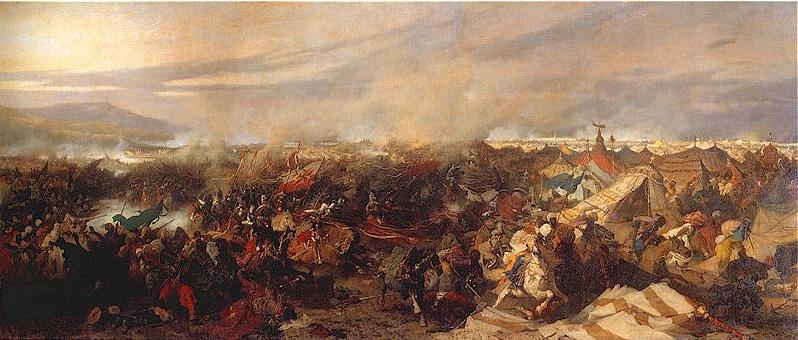
The date of 11 SEP is one pregnant with history. So is the 12th (though some say the event in question was 11 SEP - I bet al Qaeda does) - and one we should take a moment to recognize a great man who the West owes to no small measure its freedom to.
As the song goes; Istanbul was once Constantinople. What stopped Vienna being something else?
The battle started before all units were fully deployed. Early in the morning, at 4 AM, the Turks attacked, seeking to interfere with the deployment of the Holy League troops. Charles of Lorraine moved forward with the Austrian army on the left and the German forces in the center.Though most give, rightly, much of the credit to the Polish King Sobieski - there is another man who the West owes great thanks to. It is that man on the upper right; St. Marco D'Aviano.
Mustafa Pasha launched a counter-attack, with most of his force, but held back some of the elite Janissary and Sipahi units for a simultaneous assault on the city. The Turkish commanders had intended to take Vienna before Sobieski arrived, but time ran out. Their sappers had prepared another large and final detonation under the Löbelbastei,[4] to breach the walls. While the Turks hastily finished their work and sealed the tunnel to make the explosion more effective, the Austrian "moles" detected the tunnel in the afternoon. One of them entered and defused the load just in time.
At that time, above the "subterranean battlefield", a large battle was going on, as the Polish infantry launched a massive assault upon the Turkish right flank. Instead of focusing on the battle with the relief army, the Turks tried to force their way into the city, carrying their crescent flag.
After twelve hours of fighting, the Poles held the high ground on the right. The Holy League cavalry waited on the hills, and watched the infantry battle for the whole day. Then at about 5 PM, the cavalry attacked in four groups. One group was Austrian-German, and the other three were Polish. Over 20,000 men, charged down the hills (one of the largest cavalry charges in history). The charge was led by Sobieski at the head of 3,000 Polish heavy lancers, the famed "Winged Hussars". The Lipka Tatars who fought on the Polish side wore a sprig of straw in their helmets to distinguish themselves from the Tatars fighting on the Turkish side. The charge broke the lines of the Ottomans, who were tired from the long fight on two sides. In the confusion, the cavalry headed straight for the Ottoman camps, while the remaining Vienna garrison sallied out of its defenses and joined in the assault.
The Ottoman troops were tired and dispirited following the failure of both the sapping attempt and the brute force assault on the city. The arrival of the cavalry turned the tide of battle against them, sending them into retreat to the south and east. In less than three hours after the cavalry attack, the Christian forces had won the battle and saved Vienna.
After the battle, Sobieski paraphrased Julius Caesar's famous quote by saying "Venimus, Vidimus, Deus vicit" - "We came, We saw, God conquered".
Awww....I'll give him the legend.An impassioned preacher, Marco d'Aviano played an important role in maintaining unity among the 'Holy League' armies of Austria, Poland, Venice, and the Papal States under the leadership of the Polish king Jan III Sobieski. In the decisive Battle of Vienna (1683), the 'Holy League' armies succeeded in repulsing the invading Ottoman Turks. There is, however, no basis in fact for the legend that, during the fighting, Marco d'Aviano brandished a crucifix at the Turks, shouting, 'Behold the Cross of the Lord: Flee, enemy bands!' He spent the time of the battle praying in a chapel. From 1683 to 1689 he participated in the military campaigns in the role of promoting good relations within the Imperial army and to help the soldiers spiritually. His assistance helped to bring about the liberation of Buda in 1686 and Belgrade in 1688. In 2003, he was beatified by Pope John Paul II.
A man who to this day gets spat on for it, the Islamists can't stand the guy. Perhaps he should be the Patron Saint for the USA (Catholic folks - is there one already?), I think we can feel his pain. Just a bit more about him here, here, here, here, and here. Think of him today - last year a Good German did.
As Navy folks, we should especially like the guy and give thanks to him every morning. You see, he was of the Capuchin Order, .... kind of sounds like Cappuccino, doesn't it?
In the early morning of September 12, 1683 the Christian army, having participated in the Holy Mass, and responding to the Friar’s preaching and encouragement attacked the Ottoman’s camp. The Christian army, under the command of John Sobieski, King of Poland, and led by Marco d’Aviano were able to use the element of surprise to defeat the enemy’s much stronger army.PS: The picture (besides the paintings) is mine from last time I was in Vienna. Life ain't all that bad.
In retreat the Turks – in addition to leaving behind the important harem belonging to commander Kara Mustafa – abandoned 500 bags of coffee beans, a daily beverage for the Turks, but still unknown in the West.
A certain Brother Diodat, considered by many as the one who introduced coffee to Europe, captured many of those bags and sold some of them in Vienna. But the Viennese did not like the bitter beverage, so they added honey, milk and cream, typical local products. The resulting beverage had great success among the soldiers and the population.
That’s how Cappuccino, the innovative beverage, colored white and brown like the Capuchin Friar’s frock-coat, was born and was named after the religious order.










No comments:
Post a Comment